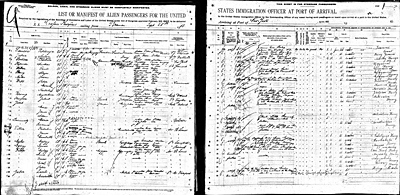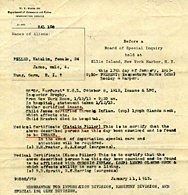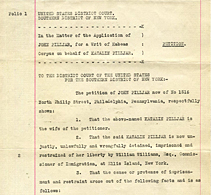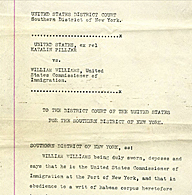
Ellis Island's Board of Special Inquiry: Case Study of Katelin Pilljar
Ellis Island's Board of Special Inquiry: Case Study of Katelin Pilljar
- Description
- Documents
- Discussion Questions
- Extension Activities
- Standards
- Additional Resources
- Contact Us
Description
At the height of immigration in the early 20th century, with thousands of immigrants entering the United States every day, the initial immigration inspectors did not have enough time to fully investigate each individual suspected of violating the immigration law. Instead, these suspected immigrants would be referred to a Board of Special Inquiry which would hold hearings to decide the merits of the individual immigrant's case. While the most common violation was to be considered a "likely public charge" (or LPC) on economic or medical grounds, people could be deported for a variety of reasons. Though approximately 10% of immigrants would experience hearings of the Board of Special Inquiry at Ellis Island, only 2% of immigrants were deported for legal or medical reasons.
The National Archives at New York City's records contain details of these investigations. As part of a Habeas Corpus case filed by the immigrant's family against the Commissioner of Immigration for detaining their family member, evidence would be provided by both sides detailing the immigrant's beliefs, economic conditions, and medical status. Among these records are transcripts of testimony from the Board of Special Inquiry, medical certificates, letters from family members, and other documents. These documents can be used to show students the process of immigration to the United States and the laws established to prevent certain people from walking through the Golden Door.
Documents
Discussion Questions:
- According to the return of the writ of habeas corpus, why was Katalin referred to a Board of Special Inquiry?
- Why did the Board of Special Inquiry recommend exclusion and deportation for Katalin? Why did they recommend the same for her son Janos?
- In the Board of Special Inquiry transcript, how would you describe the line of questioning by the immigration officials? Support your opinion with a specific quote.
- In the Board of Special Inquiry transcript and in his petition, what does Katalin's husband point to as the cause of her behavior?
- What was the result of the inquiry? Do you think they made the right decision? Why or why not?
- According to the Passenger Arrival record, how long was the person detained? What ship did they return on?
Extension Activities
- Debate the Issue: Did Katalin Pilljar get a fair hearing? Why or why not?
- Connections to Today: How does the process of immigrating to the United States today differ from that time period?
- Connections to Today: Do you think Katalin would have had problems entering the United States today? Why or why not?
- Further Research: Compare and Contrast (person's name) experience with a Chinese Exclusion case? What about the process is similar? What is different?
Standards
- National History Standards
- Era 6: The Development of the Industrial United States
- Standard 2A: The student understands the sources and experiences of the new immigrants.
- Standard 2A: The student understands the sources and experiences of the new immigrants.
- Era 6: The Development of the Industrial United States
- NY Standards
- SS1.C.1. The study of New York State and United States history requires an analysis of the development of American culture, its diversity and multicultural context, and the ways people are unified by many values, practices, and traditions.
- SS1.C.3. Study about the major social, political, economic, cultural, and religious developments in New York State and United States history involves learning about the important roles and contributions of individuals and groups.
- SS1.C.4. The skills of historical analysis include the ability to: explain the significance of historical evidence; weigh the importance, reliability, and validity of evidence; understand the concept of multiple causation; understand the importance of changing and competing interpretations of different historical developments.
- NJ Standards
- 6.1.8.D.4.a Analyze the push-pull factors that led to increases in immigration, and explain why ethnic and cultural conflicts resulted.
- 6.1.12.D.3.b Explain how immigration intensified ethnic and cultural conflicts and complicated the forging of a national identity.
- 6.1.12.D.5.d Relate varying immigrants' experiences to gender, race, ethnicity, or occupation.
- 6.1.12.A.8.c Relate social intolerance, xenophobia, and fear of anarchists to government policies restricting immigration, advocacy, and labor organizations.
Additional Resources:
- Immigration and Naturalization
- Genealogists/Family Historians
- Teaching With Documents:Affidavit and Flyers from the Chinese Boycott Case
Contact Us
If a teacher finds unique and effective ways to use these documents in their classroom and would like to share them with other teachers, please contact christopher.zarr@nara.gov



